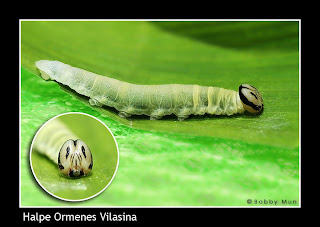Skippers are butterflies that are very easily mistaken for moths. They belong to a family of butterflies called Hesperiidae (Pronunciation: hess-pah-RYE-i-dee).
The Hesperiidae is a large family of butterflies with about 3,500 species world-wide, of which 52 have been recorded in Singapore. They are usually classified into seven subfamilies; three of which are recorded in Singapore (Coeliadinae, Hesperiinae and Pyrginae).
- Coeliadinae
- Hesperiinae
- Heteropterinae
- Megathyminae
- Pyrginae
- Pyrrhopyginae
- Trapezitinae
The differences between skippers and butterflies can be distinguished by their flight and the big eyes. Skippers have a thick, muscled thorax and small short wings. Their head is wider than the thick thorax and most of the species’ antennae are widely spread and hooked at the end (a structure known as apiculus).
The flights of the skippers are powerful and extremely fast and tend to be very darting, skipping from place to place. That’s why it’s called “Skippers”. Most skippers are small or medium sized. Many skippers are not only small, but they look alike with a few tiny light spots on the wings and are extremely difficult to identify. Most have brown, grey, orange or dull colors. Their four wings operate more or less independently when they are resting. Skippers open their hind wings like moths and not vertical like other species of butterflies.
An opened wings of a Chocolate Demon resting on a grass blade.

The eggs are oviposited singly on the upper surface of grasses or leaves of the host plant. The egg may be ribbed or smooth in a kind of “disc-shaped” or hemispherical shape. After about 2-3 days, the larva hatches from the egg. As it makes its way out of the egg shell, the tiny young larva consumes the eggshell partially for its exit.
Matting pair of the Taractrocera archias quinta

Caterpillars have large heads, made more noticeable because the prothorax is narrow and has the appearance of a neck. Individual caterpillars create shelters for themselves by biting one side of the leaf to make a small flap, folding over a piece of leaf or tying a couple of leaves together with its silky thread, such that they are not generally seen out in the open. They will leave one opening entrance as a ‘door’ for them to crawl to feed at night on near-by leaves, returning to their shelter during the day. They will remain in the silk-lined shelter or so called “leaf-nests” until they change instars. This is because they become too large for the nests after the change. This habitation continues until the 5th instars.
A banana skipper creating a shelter by folding a leaf.
Caterpillar of a Halpe Ormenes Vilasina
When the caterpillars stop feeding, pupation takes place inside the shelter or within the plant. Seven to twelve days later, the pupa becomes darkened in color - signaling the imminent emergence of the adult. The upperside of the forewings become visible through the now transparent pupa skin, allowing one to tell the gender of the soon-to-appear adult. The next day the adult butterfly emerges from the mature pupa.
Eclosion sequence of a Orange-Tail Awl from its pupa
Pictures of skippers taken in Singapore












No comments:
Post a Comment